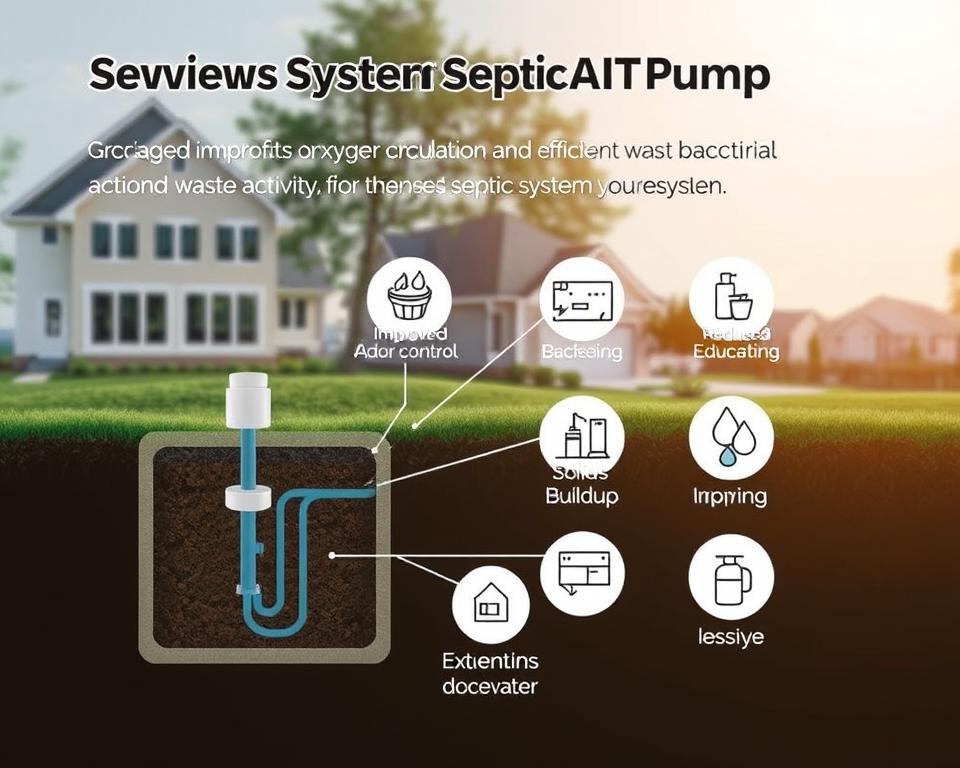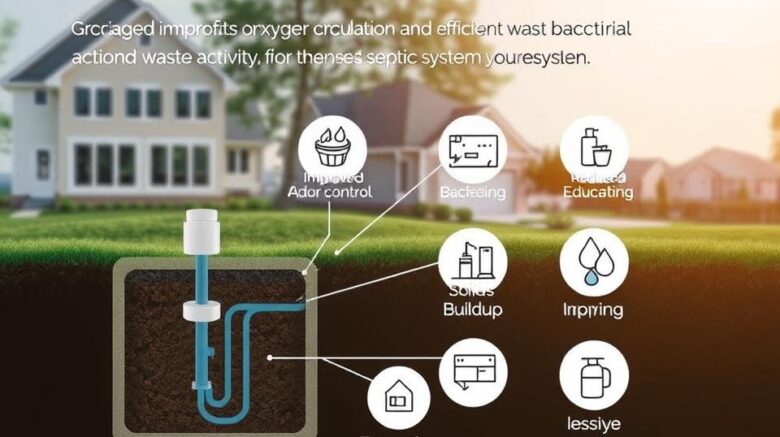Aerobic Tank Air Pump: Must-Read Guide for Residential Users
Have you ever wondered what powers your aerobic septic system’s performance? The Septic tank aerator is the unsung champion integral for your system. In this article, property owners will obtain useful information on the device’s function. It’s key for a sound, well-run Septic tank.
Understanding the value of a Septic tank air Pump can optimize your Septic system’s operation using septic tank pumping companies near me. It also safeguards your real-estate worth and surrounding ecosystem. Our handbook will introduce All in Sanitation, a well-regarded Septic industry expert. They’re eager to serve your Septic aerator Pump needs.
Salient Features
- The Septic air Pump is indispensable for aerated wastewater units.
- Maintaining your Septic system air Pump can improve overall system operation.
- Regular checks extend the durability of your Septic tank air Pump.
- Opting for the correct Septic aerator Pump is key for top operation.
- All in Sanitation delivers tailored services for Septic air Pump needs.
Understanding Aerobic Septic Units
Aerobic Septic systems offer a more effective waste treatment approach by using oxygen. This system relies on aerobic bacteria living in well-oxygenated environments. These bacteria are more efficient in processing organic matter. With the help of Septic aerator Pumps, these systems deliver a consistent oxygen supply, improving the waste decomposition process.
These systems stand out in decreasing sludge buildup, due to the hard work of aerobic bacteria. This drop in solid waste means minimal cleaning and tank Pump-outs is required less often. Additionally, they successfully handle wastewater, leading to minimal smells. This ensures a better environment for homeowners and the community overall.
To make sure these systems function properly, it’s essential to recognize the key Septic system components. These include the Septic tank, aeration chamber, and effluent Pump. Each section plays an important part, especially the air Pump. It forces oxygen into the tank, essential for the aerobic bacteria’s activity.
Importance of the Septic Air Pump
The Septic air Pump is central in the functioning of aerobic Septic systems. It serves as the system’s “oxygen source,” supplying the critical oxygen essential. This oxygen helps aerobic bacteria to flourish and process waste effectively. If the Pump fails, the system’s effectiveness diminishes, bringing about sludge accumulation and possible odors.
Such issues can undermine Septic system operations and cause environmental hazards. By recognizing how vital the Septic air Pump is, homeowners can move early. They can ensure its best function through scheduled service. This stops failures, prevents costly repairs, and preserves the aerobic system’s condition.
Key Benefits of Using a Septic Air Pump
Running a Septic air Pump greatly improves the capability of Septic systems. Septic air Pumps are vital as they fast-track the digestion of waste. This is realized by oxygenating the treatment process, stimulating aerobic bacteria growth. These bacteria are necessary for proper waste treatment.
They’re also instrumental in cutting foul smells. Due to more active aerobic processes, waste is processed faster, thus reducing odors. This creates a nicer atmosphere for homeowners.
Another significant benefit is the reduction in sludge buildup. Consequently, tanks demand less frequent Pumping, conserving both money and time. Greater processing not only reduces spending but also increases the lifespan of the drain field.
Maintaining these Pumps diligently means less frequent repair costs and satisfying regulatory standards. Thus, the upsides of Septic air Pumps extend past for homeowners. They also enhance environmental health by advancing waste management practices.
| Benefit | Description |
|---|---|
| Fast Waste Breakdown | Enhanced aerobic activity hastens the decomposition process. |
| Minimized Odor Emissions | Better treatment efficacy produces fewer odors. |
| Reduced Sludge Buildup | Minimal Pumping and maintenance are called for. |
| Extended Drain Field Life | Better treatment translates to a healthier drain field. |
| Cost Savings | Lower likelihood of repairs and regulatory compliance cost. |

Finding a Suitable Septic Air Pump
Selecting the proper Septic air Pump is essential for an effective aerobic system. Homeowners should assess various factors for the ideal match. The dimensions of the tank and the airflow specifications matter greatly the Pump’s performance.
To make an informed choice, it’s essential to know the air Pumps available. There are mainly two types: linear diaphragm Pumps and rotary vane Pumps. Each delivers particular pluses, which should be paired with your home’s individual circumstances and how it operates.
Power consumption also matters. Picking a Pump that cuts energy use while providing the needed airflow can result in noticeable cost cuts. Support from All in Sanitation experts can be extremely useful. They make certain the Pump you choose fits your system’s requirements exactly.
Major Kinds of Septic Air Pumps
Homeowners can decide more effectively by recognizing the various Septic air Pumps available. There are mainly two types: diaphragm Pumps and rotary vane Pumps. Each has its particular functions and benefits.
Diaphragm Pumps, known for their quiet operation, are preferred for residential Septic systems. They offer energy efficiency while ensuring stable air output. Their trustworthy performance matches smaller systems, preferred by many homeowners.
Rotary vane Pumps, however, are well-suited for extended or commercial systems. These Pumps provide increased power, required when handling bigger loads. Their strong build allows efficient operation in broad Septic systems.
| Type of Pump | Best Use | Advantages |
|---|---|---|
| Diaphragm Pumps | Residential Systems | Quiet operation, energy-efficient, reliable air flow |
| Rotary Vane Pumps | Larger or Commercial Systems | Powerful performance, high capacity, durable construction |
Knowing the contrasts in Septic air Pumps is key for upgrades or replacements. Each Pump type delivers specific features to meet various needs. This provides optimal performance for any system.
Indicators You Require a Septic Air Pump Replacement
Homeowners must monitor Pump failure signs in their Septic systems. Some clues show the need for a Septic air Pump replacement. These ensure continued performance. Noticing these promptly stops major issues.
Signs of potential problems include:
- Unusual noises from the Pump, like grinding or trembling, might mean internal damage.
- A clear lack of air output indicates the Pump isn’t performing as intended, affecting efficiency.
- Frequent electrical problems, such as tripped breakers or flickering lights, could point to overloading.
- Visible damage on the Pump unit, with fractures or leaks, demands quick action.
- Bad smells in the yard often signal a compromised Pump, demonstrating ineffective effluent aeration.
Recognizing these signs early avoids expensive repairs or total system failure. Scheduling periodic reviews assists in finding these issues. It also confirms if you require a new Septic air Pump.
Upkeep Advice for Your Septic Air Pump
For an well-running Septic air Pump, consistent service is necessary. This guarantees that your system operates correctly. Homeowners can use several straightforward care strategies for best results.
Every six months, perform a detailed inspection for wear or damage. It is also essential to swap out the filters as advised. This stops clogs that could hamper efficiency.
The Pump should be placed on a solid base to lessen vibrations, which could damage it over time. A protective cover is essential too. It protects against debris and water, sustaining the Pump’s functionality.
Proper maintenance can notably lengthen the life of your Pump. In turn, this benefits the Septic system’s performance collectively.
| Maintenance Task | Frequency | Benefits |
|---|---|---|
| Inspect Pump for damage | Every 6 months | Catches problems quickly |
| Replace filters | As needed | Keeps performance up |
| Check surface stability | Annually | Reduces vibrations |
| Clear debris around Pump | Monthly | Maintains airflow |
Setting Up Your Septic Air Pump
Effective installation of your Septic air Pump is key for its optimal operation. Initially, choose a reliable, moisture-free area for placement. The chosen spot should reliably bear the Pump’s weight with ease.
To effectively mount your Pump on your own, observe the following guidelines:
- Prepare all necessary items, including the Pump, a power source, and hose fittings.
- Carefully read the manufacturer’s guidelines before kicking off your installation.
- Ensure every connection is proper to prevent air leaks that hurt performance.
- After assembly, run a test to ensure the system works as intended.
If the installation process feels tricky, get in touch with All in Sanitation. Their professionals can sidestep common errors, guaranteeing your setup follows necessary safety requirements.
Benefits of Choosing All in Sanitation for Your Septic Air Pump Needs
When choosing a Septic service provider, the choice is significant. All in Sanitation sets itself by delivering dependable Septic air Pumps. They address varied homeowner requirements with a comprehensive selection of quality products. This guarantees customers get an perfect match for their Septic systems.
What really sets apart All in Sanitation is more than their extensive product lineup. Their devotion to excellent customer service is also noteworthy. Homeowners get knowledgeable support, helping them choose trusted Septic solutions. This collaboration is key to customize each solution to fulfil specific needs.
All in Sanitation also emphasizes aftercare to secure lasting satisfaction. Their commitment extends beyond the initial sale. They deliver ongoing support to maintain Septic systems functioning optimally for the foreseeable future.
Cost Considerations for Septic Air Pumps
Appreciating the costs linked to Septic air Pumps is essential for homeowners who run aerobic Septic systems. Up front, one faces the purchase price, which includes the Pump and necessary accessories. Installation expenses fluctuate, in line with the system’s complexity and any adjustments required.
Ongoing upkeep forms an additional cost layer. Routine checks can fend off bigger issues, which can mean savings. Homeowners should allocate money for Septic maintenance to retain the Pump’s effectiveness and longevity. Such planning avoids expensive repairs later on, showing the advantage of proactive maintenance.
| Cost Component | Average Cost Range |
|---|---|
| Septic Air Pump | $500 – $1,200 |
| Installation | $300 – $800 |
| Annual Maintenance | $150 – $400 |
| Potential Repair Costs | $1,000 – $5,000 |
Dividing Septic air Pump expenses into specific parts helps homeowners in budget planning. This detailed approach secures the system’s consistent operation and their confidence.
Final Thoughts
For homeowners with aerobic Septic systems, looking after Septic systems is essential. The right Septic air Pump boosts waste processing and increases your system’s life. Committing to ongoing care and swiftly handling issues prevents costly fixes and disruptions.
Opting for a Septic air Pump requires attention. This guide showed how to make smart choices about installation and replacement. With All in Sanitation’s help, you can navigate your Septic systems’ complexities confidently.
Attending to your Septic air Pump promotes your system’s operation and durability. It guarantees a reliable and effective operation over time. Keep in mind, your home’s wastewater management is strongly influenced by ongoing maintenance.
